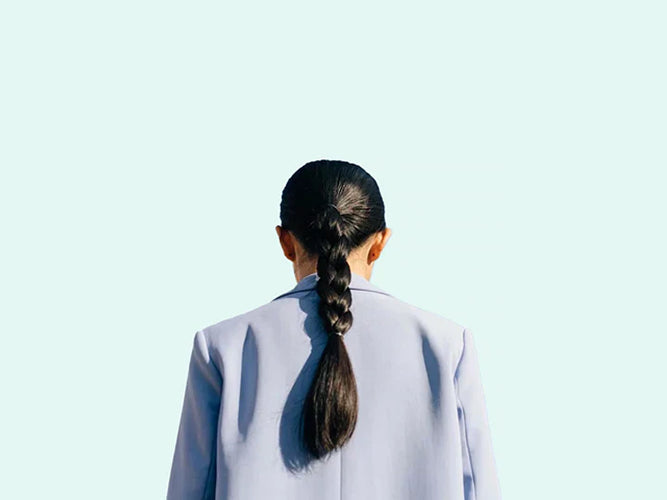- What is traction alopecia?
- How do tight hairstyles cause hair loss?
- How to recognise the signs of traction alopecia
- Tight hairstyles without the risk of traction alopecia
- What is the difference between traction alopecia and other types of alopecia?
- Frequently Asked Questions about traction alopecia
- Conclusion
Tight hairstyles can look neat and stylish, but in the long term they can also cause damage. Constant tension on the hair and scalp may lead to hair loss. This type of hair loss is called traction alopecia. In this article, you will learn what it is, how to recognise it, and what you can do to keep your hair healthy.
What is traction alopecia?
Traction alopecia is hair loss caused by repeatedly pulling on the hair. When your hair is tied tightly, constant small forces are applied to the hair follicles. Over time, this can cause hairs to loosen or become thinner, especially around the hairline and temples.
This type of hair loss does not result from hormones or a medical condition, but from mechanical stress: literally pulling on the hair. It can occur with tight ponytails, braids, buns, or when wearing hair extensions.
In the early stages, hair can often grow back once the tension is reduced. However, with prolonged strain, the follicles can become permanently damaged, and hair may not return.
How do tight hairstyles cause hair loss?
When your hair is often pulled tightly, continuous tension is placed on the roots. The hair root is firmly anchored in the scalp, but it is sensitive. If the hair is constantly pulled, the root can become irritated, causing the hairs to loosen and eventually fall out.
The most tension usually occurs at the front of the head, around the hairline and temples. This is why these areas tend to thin more quickly with tight ponytails, braids, or buns. Not only how tight your hairstyle is, but also how often you wear it, plays a role. Wearing tight styles every day without giving your hair a break does not allow the follicles to recover.
How to recognise the signs of traction alopecia
- Traction alopecia usually develops gradually, which makes it hard to notice at first. However, there are several signs that can indicate tension-related damage.
- Thinning hair along the hairline or temples. The hairline slowly moves back as this area experiences the most tension.
- Short, broken hairs. These feel rough and stick out shorter than the rest, often the first sign of too much pulling.
- A sensitive or itchy scalp. Prolonged tension can cause irritation or a tight, pulling sensation.
- Bald or thinning patches in areas where tight hairstyles are worn. Especially in people who regularly wear the same braids, buns, or weaves.
- Changes in hair density or texture. Hair may feel thinner or softer in areas exposed to long-term tension.
Tight hairstyles without the risk of traction alopecia
Not every tight hairstyle is immediately harmful. The key is variation and giving your hair rest. With the right habits, you can keep your hair healthy even if you prefer sleek styles. Make sure your hairstyles do not pull on the same areas of hair for too long or too often, so the follicles have time to recover.
Here’s how to reduce strain on your hair:
- Wear hairstyles more loosely and avoid tight styles every day.
- Change your hairstyle regularly so the same hairs are not under constant tension.
- Use soft scrunchies or metal-free hair ties to prevent breakage.
- Use a gentle shampoo and nourishing conditioner to keep your hair and scalp in good condition.
- Let your scalp breathe and rest regularly.
Extra tip: Sleep on a silk or satin pillowcase. It reduces friction, helping prevent breakage and keeping the hair smooth.
What is the difference between traction alopecia and other types of alopecia?
There are several hair loss causes (alopecia). Traction alopecia is a mechanical form caused by external tension, such as tight hairstyles or extensions.
Androgenetic alopecia, on the other hand, is caused by genetic and hormonal factors. It often appears in men as a receding hairline or thinning at the crown, and in women as overall thinning on the top of the head.
Alopecia areata is different. It is an autoimmune condition in which the immune system attacks the hair follicles, resulting in round bald patches.
The key difference is that traction alopecia is not caused by your body itself but by external pulling forces. That means you can often do something about it by adjusting your hairstyling habits and allowing your scalp to rest.
| Type of hair loss | Cause | Where visible |
| Traction Alopecia | Tension on hair roots | Hairline, temples |
| Androgenetic Alopecia | Genetic, hormonal cause | Crown, receding hairline |
| Alopecia Areata | Autoimmune reaction | Round bald patches |
Frequently Asked Questions about traction alopecia
Is traction alopecia permanent?
It depends on how long and how strong the tension on the hair has been. In the early stages, hair often grows back once you change your hairstyle habits in time.
How do I know if my hair has permanent damage?
If your hair becomes thinner or breaks, it can usually recover once you reduce tension. However, if you see smooth bald patches where no hair is growing back, the damage may be permanent.
Can wearing a headscarf cause traction alopecia?
Wearing a headscarf does not cause hair loss. However, too much tension can occur if the scarf is tied very tightly or if the hair underneath is pulled back firmly. In that case, the pulling tension can contribute to traction alopecia over time.
Conclusion
Traction alopecia is a type of hair loss that often results from long-term tension on the hair and scalp. Tight hairstyles such as braids, ponytails, and buns can look great, but if worn too tightly, they can weaken the hair roots. The process develops gradually, so it is important to recognise early signs such as scalp sensitivity or thinning hair around the hairline.
By treating your hair gently, you can prevent much of the damage. Avoid wearing your hair too tight, switch hairstyles regularly, and allow your scalp to rest. Gentle brushing, mild hair care, and avoiding excessive heat will also help keep your hair strong. A healthy scalp is the foundation for resilient, naturally shiny hair.
Traction alopecia does not have to be a permanent problem. With the right habits, enough variation, and a caring approach, you can significantly reduce the risk of hair loss and give your hair the chance to recover.
Sources
Billero, V., Sethi, S., & Sethi, S. (2018). Traction alopecia: The root of the problem.
DermNet New Zealand. (z.d.). Traction alopecia. DermNet NZ.
This information does not replace professional medical advice. If in doubt, always consult a doctor or specialist.













